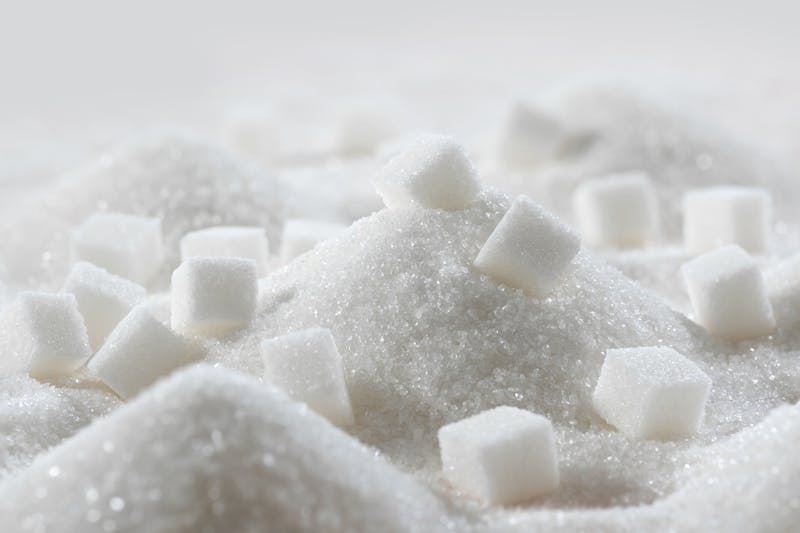
You aren’t alone if you love sugar, but it may be the reason you’re aging prematurely. If you struggle with your weight, your sugar intake is likely to be a top culprit. Sugar and weight loss are linked in a variety of ways. It’s a primary contributing factor to weight gain. It can degrade collagen, contributing to premature aging. It increases whole-body inflammation which increases the risk for chronic health conditions including obesity, heart disease, diabetes, and other concerning health conditions.
Knowledge is power, so learning how sugar works in your body may motivate you to make a few changes. You may also have some surprising sources of sugar in your daily diet.
Do We Need Sugar?
Sugar gets such a bad wrap, that you may be surprised to hear that we all need sugar to thrive. According to Harvard Medical School, the glucose in sugar is the primary source of energy for every cell in your body. It is also vital for brain health, as the brain uses 50 percent of the sugar energy in the body.
Like most nutrients, it’s all about balance. Problems arise when you consume too much sugar.
How Much Sugar Is Too Much Sugar?
Currently, around 75% of Americans consume too much sugar. How much you should consume per day is an ongoing topic of debate in the medical community and will vary by your individual health needs and wellness objectives.
The American Heart Association suggests limiting sugar to no more than 100 to 150 calories per day. For women, this is about 6 teaspoons or 24 grams. For men, this is about 9 teaspoons or 36 grams.
The truth about sugar and weight loss is: less is better if you want to lose weight or maintain your weight loss.
Is All Sugar Created Equally?
Yes, and no. Sugar occurs naturally in fruit, vegetables, dairy, nuts, and seeds. When consumed from natural sources as part of a well-balanced whole-food diet, it’s far less likely that you will consume too much. That is unless you are adding significant amounts of natural sugar sources to foods and beverages, such as agave, maple syrup, or honey.
Whether naturally occurring or a synthetic additive, it is comprised of glucose and/or fructose.
According to Harvard Medical School:
- Table sugar contains equal amounts of glucose and fructose.
- High fructose corn syrup is 45% glucose and 55% fructose.
- Agave nectar is up to 90% fructose and 10% glucose.
Unless you are diabetic, the fructose and glucose mix has little to no impact on your health or metabolic rate—sugar is sugar. The only difference is that natural sources contain fiber, vitamins, and other micronutrients. In synthetic sources, sugar is often empty calories added for flavor and preservation.
It’s also important to understand that carbs are metabolized in the body as glucose. There are over 55 names for artificial sweeteners found on food labels, so you will need to read the grams of sugar per serving.
Also, familiarize yourself with healthy sugar alternatives.
How Sugar Accelerates Aging?
Sugar and weight loss aren’t your only concern, as it can contribute to premature and accelerated signs of aging.
You have likely heard of collagen and elastin and their importance in aging. These internal fibers work together to keep skin firm, smooth, and youthful. Production of both fibers slows naturally as you age, but some of your daily habits can accelerate the decline of collagen and elastin. This includes UV damage, smoking, and eating a diet high in sugar.
Sugar causes cross-linking of collagen, resulting in stiffening and loss of elasticity of your skin.
High-sugar diets may also contribute to increased:
- Acne
- Wrinkles
- Skin sagging
- Darks spots
How Sugar Contributes to Weight Gain?
Harvard Medical School also found that most people’s daily excess sugar is consumed in beverages with added sweeteners. So even if you maintain your willpower for the pastries in the breakroom, be mindful of what you drink An 8-year-long study found that if you drink 21 or more artificially sweetened beverages per week, you double your risk of obesity.
Don’t let diet beverages fool you, as studies find that drinking diet sodas is directly linked to greater waist circumference. Try to obtain most of your fluid intake from water and unsweetened herbal tea.
Why Do Foods High in Sugar Cause Weight Gain?
Healthline highlights the top 5 ways sugar and weight loss have been scientifically linked.
- Foods and beverages that are high in sugar are typically “empty” calories that provide little to no nutritional value.
- With little to no nutritional value, you will need to eat significantly more before you feel full.
- Eating more to feel full, also means that you are likely to overeat in portion size.
- A high-sugar diet is typically low in antioxidants. This can lead to oxidative stress that causes internal inflammation, weight gain, and decreased immunity.
- Chronically elevated blood sugars can lead to insulin resistance and hormonal imbalances that have a ripple effect of increased body fat.
Am I Consuming Sugar Without Knowing It?
You might be! Many day-to-day foods and beverages typically considered to be “healthy” can be surprisingly high in sugar.
Fruit juice
Yes, fruit contains natural sugars and orange juice is packed full of vitamin C, but 8 ounces of orange juice contains 22 grams of sugar—almost a full day of sugar! Next time you make freshly squeezed juice at home or you pop into a juice bar, use or order an all-veggie juice or follow the 80/20 rule. This means using no less than 80 percent vegetables and no more than 20 percent fruits. The only vegetable commonly juiced that contains a high amount of sugar is carrots, which contains 9 grams of sugar per 8 ounces.
Non-dairy milk
Vanilla non-dairy milk typically has between 10 and 13 grams of sugar per serving. This number drops down to around 7 grams per serving in unsweetened alternatives. Refrigerated almond milk has as low as zero grams of sugar.
Gummy supplements
Gummies are a tasty and convenient way to take vitamins, minerals, and herbs. Even if the sugar is derived from fruit, the average gummy contains 2 to 5 grams of sugar per gummy. Multiply this by how many gummies you take, and the total grams may surprise you.
Café coffee
The average 16-ounce unsweetened latte contains around 18 grams of sugar. Now that you understand the connection between added sweeteners and weight loss, you can rethink your coffee order. You can cut a latte’s sugar in half (or more) by comparing the grams per serving if you substitute unsweetened non-dairy milk. Flavored coffees can have 25 to 40+ grams per serving. The average mocha has around 35 grams per serving.
Multigrain cereal
The “multigrain” food label is sometimes designed to lead you to believe that a product is healthier than it is. Many cereals don’t contain the “whole” grain, making them a refined carb that your body metabolizes as glucose. Even whole-grained granola can be very high in sugar.
Salad dressing, sauces, and marinades
Sugar is often added for flavor and as a preservative to bottled salad dressing, sauces, and marinades. Some have far less sugar than others, so read the label. If you have the time, make your own.
Sports beverages
Sports drinks are designed to replenish electrolytes after physical activity. Electrolytes are a combination of sugar, water, and salt. There is no way around the sugar in sports beverages, but some brands have significantly more sugar than others, so be sure to read the label.
Also, be mindful of the serving size.
Yogurt
While an effective way of increasing your daily calcium and probiotics, many yogurts have artificial “fruit” flavors added to them. For example, a popular brand name’s strawberry yogurts come in at 19 grams for the original blend, 7 grams for light and Greek, and 19 for whipped. Plain yogurt is between 7 to 9 grams per serving, and just 3 more grams if you add 3 large, chopped strawberries. The difference is significant.
Low-fat and low-calorie
Processed products labeled “low-fat” and “low-calorie” often keep the fat and calories low by adding more sugar. So, in your sincere effort to make a healthy food choice, you may simply be consuming more sugar.
Protein, snack, and breakfast bars
Grab-and-go bars may be a delicious snack. They may even deliver the protein required to start the day off right or recover after a workout, but many bars are high in sugar. Many snack and breakfast bars aren’t even that high in protein. As always, read the label to ensure sugar and weight loss are always top of mind.
Premade “healthy” items
Soup, juice, and smoothies can be well-rounded and low in sugar, but they can also be high in artificial sweeteners. While all fruit and vegetables contain sugar, be mindful of the added sweeteners and portion control.
Still Not Sure What To Eat?
Meal planning can be overwhelming, but you don’t have to go it alone! Valley Medical Weight Loss and Med Spa offers personalized meal plans as part of our Weekly and Monthly Weight Loss Programs.
These meal plans aren’t like the average deprivation diets. While they reduce your caloric intake, they ensure a balanced nutrient mix to fuel you throughout your day. Average weight loss is 2 to 5 pounds per week!
Yes, you can add GLP-1 to optimize your weight loss results. Or just take GLP-1 solo.
Reach out today to learn more!

